- Articles incorporating text from the Air Force Historical Research Agency
- Articles incorporating text from Wikipedia
- Nuclear cruise missiles of the United States
- Cruise missiles of the Cold War
- Nuclear missiles of the Cold War

BGM-109G Ground Launched Cruise Missile
- View history
The Ground Launched Cruise Missile , or GLCM , (officially designated BGM-109G Gryphon) was a ground-launched cruise missile developed by the United States Air Force in the last decade of the Cold War .
- 2.1 Design & employment
- 2.2 NATO Deployment & protests
- 2.3 Intermediate-Range Nuclear Forces Treaty
- 2.4 USAF BGM-109G GLCM Units
- 4 References
- 5 External links
Overview [ ]
The BGM-109G was developed as a counter to the mobile medium- and intermediate- range ballistic nuclear missiles deployed by the Soviet Union in Eastern Bloc European countries . The GLCM and the U.S. Army 's Pershing II may have been the incentives that fostered Soviet willingness to sign the Intermediate-Range Nuclear Forces Treaty (INF treaty), and thus possibly reduced the threat of nuclear wars in Europe. GLCM is also a generic term for any ground-launched cruise missile. Since the US deployed only one modern cruise missile in the tactical role, the GLCM name stuck. The GLCM was built by General Dynamics.
History [ ]
Design & employment [ ].
A conventionally configured cruise missile, the BGM-109 was essentially a small, pilotless flying machine, powered by a turbofan engine. Unlike ballistic missiles , whose aimpoint is usually determined by gravitic trajectories, a cruise missile is capable of complicated aerial manoeuvres, and can fly a range of predetermined flight plans. Also, it flies at much lower altitudes than a ballistic missile, typically with a terrain-hugging flight plan. The trade-off for this low-observability flight is strike time; cruise missiles travel far more slowly than a ballistic weapon, and the GLCM was typical in this regard.
GLCM was developed as a ground-launched variant of the Tomahawk missile in use by the U.S. Navy (along with an undeveloped air-launched version, the Medium Range Air to Surface Missile [MRASM].) Unlike other variants of the Tomahawk, the GLCM carried only a nuclear warhead; no conventional capability was provided. The W84 warhead was a variable-yield kiloton-range weapon. Some estimates put the yield at between 10 and 50 kt. This tactical warhead contrasts with the W80 warhead found on other versions of the Tomahawk, and on the ALCM, which had a yield of 200 kt. 2 The Pentagon credited the GLCM with a range of 2000–2500 kilometers. Like other US cruise missiles of this period, accuracy after more than 2000 km of flight was within half the width of an American football field or 100 ft (approximately 30 meters). The missile was entirely subsonic, powered by a turbofan engine with a rocket booster assisting at launch. 3
Militarily, the GLCM was targeted against fixed targets—at the outer edge of its range, the missile's flight time with its subsonic turbofan was more than 2½ hours. The missiles were launched from an elevated launcher, with the missile ejected from its canister for about 13 seconds of solid rocket booster flight. The fins extended at 4 seconds, the air inlet and wings deployed at 10 seconds and the jet engine started at the end of the boost phase. Flying at low level, the missile was guided by TERCOM (terrain contour matching) to the target. 3
This contrasted sharply with Pershing II , which had a flight time of 10–15 minutes. However, the range of the GLCM gave it the ability to strike deep within then- Soviet territory, and the weapon's guidance, and low radar cross-section would have made it far more difficult to intercept a GLCM even if the launch were detected in time.
BGM-109G personnel were trained at Davis-Monthan AFB , Arizona, by the 868th Tactical Missile Training Squadron from 1 July 1981 to 1 October 1985, when it became the 868th Tactical Missile Training Group. The group was inactivated on 31 May 1990. An area near Fort Huachuca , Arizona was used for field training for GLCM flights. GLCM testing was conducted at the Dugway Proving Ground in Utah, with many of the people involved in the testing going to operational wings as they were activated.
NATO Deployment & protests [ ]
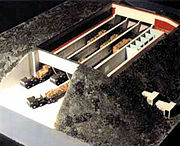
Ground Launched Cruise Missile GAMA (GLCM Alert and Maintenance Area)

GAMAs at RAF Molesworth , England. 4 GAMAs, 1 per flight, each holding 16 missiles, total 64 missiles. Molesworth was completely reconstructed between 1981 and 1985, being transformed from a largely abandoned World War II Eighth Air Force B-17 base to a modern NATO facility. Note the large World War II "J" type hangar in the upper left. It was retained as a memorial to the WW II 303d Bombardment Group. Both Bob Hope and Glenn Miller performed USO shows in that hangar during the war years.

A dispersed launch site for a BGM-109G Gryphon missile TEL
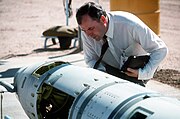
A Soviet inspector examines a BGM-109G ground-launched cruise missile in 1988 prior to its destruction.
BGM-109G missiles would be based at six locations throughout Europe; in the United Kingdom (at RAF Greenham Common and RAF Molesworth ), Belgium, Netherlands, Germany, and Comiso Air Station in Italy. Each location had its own unique problems, but all required extensive construction by the USAF. Initial operating capability (or IOC) occurred in 1983. 4
Normal basing was in shelters at military installations. Each BGM-109G station was controlled by a Wing, that consisted of a Tactical Missile Squadron (TMS) which was responsible for operation and deployment of the missiles, and a Tactical Missile Maintenance Squadron (TMMS) which was responsible for the support of the system. Each TMS consisted of several flights, made up of 69 people and 22 vehicles. 4 The missile was designed to operate in a flight with sixteen missiles. The flight would be normally on base, with the missiles and vehicles secured in the hardened storage area called the GAMA (GLCM Alert and Maintenance Area). Four transporter erector launchers (TEL) each carried four BGM-109G missiles in their containers and ready for launch. Two launch control centers (LCC), each with two launch officers, were connected to the TELs and interconnected for launch. Each TEL and LCC was towed by a large MAN KAT1 8x8 tractor and was capable of traversing rough terrain. There were 16 support vehicles for the flight commander, normally a captain, 19 maintenance technicians, a medical technician and 44 security personnel. 4
During periods of increased tension, the flights would be deployed to pre-surveyed, classified locations in the countryside away from the base. The members of the flight would dig in, erect camouflage netting to hide the vehicles and prepare for launch. Flight commanders were tasked to survey and select more than one possible deployment site, with all details closely held, and the commander selected the location preferred when the flight deployed from the base. When deployed, the flight was self-sustaining, and secured with special intrusion detection radar. The launchers (sans warheads) were sent out on a number of simulated scrambles. 4
Although deployed in the face of a range of Soviet IRBMs , including the brand-new and extremely capable SS-20 Saber, the GLCM (sometimes referred to by its phonetic nickname, Glick-em) faced widespread public protest in Europe. Many anti-nuclear Europeans felt that the United States was deploying weapons meant to win a tactical nuclear war, without adequate consideration of the effects that even a 'victory' would bring. Critics also argued that the Reagan Administration was unduly escalating tensions in Central Europe. Between them, GLCM and Pershing II made a lethal combination. GLCM missiles could be launched, undetected, followed 2 hours later by a Pershing strike, which would fly so quickly that it was possible no response could be made before the Pershings struck. Aside from presenting an attractive course of action to NATO commanders in the event of Soviet aggression, it put the Kremlin leaders (in range of the GLCM and possibly the Pershing, even in Moscow) in a position of fearing a decapitating NATO first strike, which could have moved them toward a launch on warning policy as the only way to maintain deterrence . 5 However, the USSR did have submarine-launched missiles (i.e. Golf and Hotel class SSBNs armed with R-27 Zyb and SS-N-5s ) available during this time, so any fears of a decapitating first strike were not necessarily justified. [1]
Intermediate-Range Nuclear Forces Treaty [ ]
Despite initial fears of greater instability, the deployment of GLCM ultimately caused Soviet leaders to enter into negotiations for, and finally signature of, the INF treaty . The recognition by Soviet leaders of the threat posed by the GLCM and Pershing II missiles made them far more inclined to agree to negotiate their own intermediate-range weapons, especially the SS-20, out of service, in exchange for the elimination of the threat posed by the GLCM and the Pershing II. 6
Unlike SALT II or START I , which set limits to maximum nuclear arsenals, the INF Treaty banned whole categories of intermediate-range tactical nuclear weapons outright. All ground-launched cruise missiles and ballistic missiles with ranges greater than 500 but less than 5500 kilometers were barred to the U.S. and USSR under this treaty. This meant the withdrawal of GLCM and Pershing II on the American side; the Soviets withdrew the SS-4 Sandal , SS-5 Skean , SS-12 Scaleboard , SS-20 Saber , SS-22 Scaleboard B, and SS-23 Spider MRBM / IRBM / LRBM ballistic missiles, in addition to the GLCM's most direct counterpart: the SSC-4 or RK-55 (dubbed the Tomahawksi in the Western press) and its supersonic follow-on, the SSC-X-5 cruise missiles. 7
GLCM was removed from Europe beginning in 1988, and over the next three and a half years all units were transported to Davis Monthan AFB and destroyed or converted into displays by 1991. Eight missiles survive for inert static display only. No follow-on design has been authorized. 8
USAF BGM-109G GLCM Units [ ]
- 38th Tactical Missile Wing - Wueschheim AB, West Germany (1985–1990)
- 303d Tactical Missile Wing - RAF Molesworth , United Kingdom (1986–1989)
- 485th Tactical Missile Wing - Florennes Air Base , Belgium (1984–1989)
- 486th Tactical Missile Wing - Woensdrecht Air Base , Netherlands (1987–1988)
- 487th Tactical Missile Wing - Comiso Air Base , Italy (1983–1991)
- 501st Tactical Missile Wing - RAF Greenham Common , United Kingdom (1982–1991)
- 868th Tactical Missile Training Squadron , Activated 1 July 1981
[2]
Note: Each GLCM squadron was further subdivided into several flights. Each flight included 2 Launch Control Vehicles (LCC) and 4 Transporter Erector Launchers (TEL), totalling 16 missiles per flight. Each TEL could carry 4 missiles. [3] [4]

See also [ ]
- Tomahawk SLCM
- SSC-X-4/RK-55
- List of nuclear weapons (incomplete)
References [ ]
- ↑ The Short, Happy Life of the Glick-Em
- ↑ AAFM Newsletter, Volume 12, Number 4, dated December 2004, article "GLCM Part I" by Col (Ret) Charlie Simpson.
- ↑ Association of Air Force Missileers
- Note 1: Cochran, Thomas et al. (1984). Nuclear Weapons Databook Volume I: U.S. Nuclear Forces and Capabilities . Natural Resources Defense Council. ISBN 0-88410-173-8 . , pp. 179–184.
- Note 2: Cochran, Thomas et al.. op. cit . , pp. 79–80.
- Note 3: Cochran, Thomas et al.. op. cit . , pp. 179–184.
- Note 4: General Dynamics/McDonnell Douglas BGM-109G "Gryphon" Ground-launched Cruise Missile
- Note 5: Grier, Peter. "The Short, Happy Life of the Glick-Em". pp. 70–74.
- Note 6: Werrell, Kenneth P (1989). "The Weapon the Military Did Not Want: The Modern Strategic Cruise Missile". pp. 419–438. Digital object identifier: 10.2307/1986108 .
- Note 7: INF Theater / Operational Missiles - Russian / Soviet Nuclear Forces
- Note 8: General Dynamics/McDonnell Douglas BGM-109G "Gryphon" Ground-launched Cruise Missile
External links [ ]
- GLCM (Ground-Launched Cruise Missile): BGM-109G Gryphon - Designation Systems
- 485th Tactical Missile Wing
- 38 TMW Wueschheim Germany
- Online Application
- Committees and Meetings
- Odes to Missileers
- AAFM and the Cuban Missile Crisis
- The Missile Competition
- AAFM History
- The Missile Badge
- AAFM Art Projects
- AAFM Online Museum
- Places to Visit
- Preserving History and Heritage
- Enlisted Heritage Hall
- Key ICBM History
- Peacekeeper ICBM
- R&D ICBM
- Missiles and Missileers in the News
- Newsletter Archive
- Meetings and Reunions
- From The Director
- In The News
- From The Air Force
- Congressional
- Scholarships
- Hall of Fame
- Acknowledgements
- Brief History of USAF Organizational Emblems
- Reproductions, Heritage, and Reunion Patches
- Understanding Gallery's Methodology
- Adding a Patch to the Gallery
- Use Permissions
- Navigating the Gallery
- Patch Gallery Index
- AAFM Logo Items
- Third Party Sales
Mailing address:
P.O. Box 1767
Monument, CO 80132
Tomahawk Development
The U.S. Navy began its development of sea-launched cruise missiles in 1972. 2 The Tomahawk was designed to fly at subsonic speed while maintaining a low altitude, making it difficult to detect on radar. It uses tailored guidance systems to maneuver while at such low elevations.
There were three original Tomahawk designs, the nuclear-tipped TLAM-N, the ground-launched Gryphon, and the conventional TASM.
BGM-109G Gryphon
In late 1970s, the U.S. Navy sought a precision land attack cruise missile capable of a much smaller CEP. Two Block II versions were produced; the TLAM-C and the TLAM-D.
Service History
The Tomahawk was first deployed in combat in the 1991 Gulf War in Operation Desert Storm, with the first salvo launched from the USS Paul F. Foster (DD 964) at Iraqi targets. 18 Overall, the mission achieved initial success.
However, before GPS guidance was implemented, the Tomahawk faced serious navigation issues in 2003’s Operation Iraqi Freedom. Due to the indistinct desert terrain in region, the missile’s TERCOM system was not adequate to guide the missile to its targets in Iraq. 19 Approximately ten Tomahawks drifted off course and crashed (”clobbered”) into the ground in Turkey, Saudi Arabia, and Iran in the initial phase of Iraqi Freedom. 20
- “Tomahawk Cruise Missile,” United States Navy Fact File, August 14, 2014, http://www.navy.mil/navydata/fact_display.asp?cid=2200&tid=1300&ct=2
- “Tomahawk Cruise Missile,” United States Navy Fact File, August 14, 2014, http://www.navy.mil/navydata/fact_display.asp?cid=2200&tid=1300&ct=2.
- Sam LaGrone, “West: U.S. Navy Anti-Ship Tomahawk Set for Surface Ships, Subs Starting in 2021,” USNI News , February 18, 2016, https://news.usni.org/2016/02/18/west-u-s-navy-anti-ship-tomahawk-set-for-surface-ships-subs-starting-in-2021.
- “Tomahawk Long-Range Cruise Missile,” Naval Technology, http://www.naval-technology.com/projects/tomahawk-long-range-cruise-missile/.
- “RGM/UGM-109 Tomahawk,” in IHS Jane’s Weapons: Strategic 2015-2016, ed. James C. O’Halloran (United Kingdom: IHS, 2015), 219-223.
- “General Dynamics/McDonnell Douglas BGM-109G Gryphon” National Museum of the Air Force, April 26, 2011.http://www.nationalmuseum.af.mil/factsheets/factsheet.asp?id=18194.
- Missile Defense Project, “Tomahawk,” Missile Threat, Center for Strategic and International Studies, September 19, 2016, last modified June 15, 2018, https://missilethreat.csis.org/missile/tomahawk/ .
- Fuller, Malcolm. “Tomahawk/RGM/UGM-109B/C/D/E” Jane’s Weapons: Naval. December 17, 2012.
- Department of the Navy, Naval Vessel Historical Evaluation – Paul F. Foster Final Determination (Washington, DC: 2013), https://www.navsea.navy.mil/Portals/103/Documents/TeamShips/SEA21/InactiveShips/Historic/2013/EDD964-Paul-F.-Foster-Final-DOI.pdf.
- “The Tomahawk Missile’s First Mission Was Over…Iran?,” War on the Rocks, April 6, 2015, https://warisboring.com/the-tomahawk-missile-s-first-mission-was-over-iran/.
- Jeffrey Lewis, ”Why the Navy Should Retire TLAM-N,” Arms Control Wonk (blog), December 13, 2009, https://www.armscontrolwonk.com/archive/202560/why-the-navy-should-retire-tlam-n/.
- “What is a Tomahawk Missile?” History.com, April 7, 2017, https://www.history.com/news/what-is-a-tomahawk-missile.
- NBC News, “U.S. Launches Missiles at Syrian Base Over Chemical Weapons Attack,” NBC News, April 7, 2017, http://www.nbcnews.com/news/us-news/u-s-launches-missiles-syrian-base-after-chemical-weapons-attack-n743636.
BGM-109G Gryphon missiles being launched [ edit ]

BGM-109G Gryphon missiles on the truck [ edit ]

other [ edit ]

Navigation menu
Raytheon (General Dynamics) AGM/BGM/RGM/UGM-109 Tomahawk
The Tomahawk is the U.S. Navy's multipurpose strategic and tactical long range precision-guided cruise missile. Launched from surface ships and submarines, it was used in action in all recent major U.S. military engagements, and will remain one of the most important missiles in the U.S. inventory for quite some time.
The BGM-109 missile has been developed in several distinct variations, which are described in separate sections of this article. These variations include:
- SLCM (Sea-Launched Cruise Missile) : BGM-109A/.../F, RGM/UGM-109A/.../E/H
- GLCM (Ground-Launched Cruise Missile) : BGM-109G
- MRASM (Medium-Range Air-to-Surface Missile) : AGM-109C/H/I/J/K/L
SLCM (Sea-Launched Cruise Missile): BGM-109A/.../F, RGM/UGM-109A/.../E/H Tomahawk
In 1971 the U.S. Navy began to study the possibility of a submarine-launched strategic cruise missile, either a larger design for launch from UGM-27 Polaris missile tubes or a smaller one for launch from torpedo tubes. In June 1972 the torpedo-tube missile was chosen, and design contracts were let to the industry in November that year for what was then called the SLCM (Submarine-Launched Cruise Missile). In January 1974, the two most promising designs were selected for a fly-off competition, and in 1975, the designations ZBGM-109A and ZBGM-110A were assigned to the designs of General Dynamics and LTV, respectively. After a few test flights by the YBGM-109A and YBGM-110A prototypes in February 1976, which included the critical transition from water to air in a sub-surface launch, the BGM-109 was declared winner of the competition. At that time, it had already been decided that the SLCM should also be launched from surface ships, and therefore the acronym was changed to Sea-Launched Cruise Missile. Flight testing of the YBGM-109A, including the TERCOM (Terrain Contour Matching) guidance system, continued during the following years.
In January 1977, the Carter administration initiated a program called JCMP (Joint Cruise Missile Project), which directed the USAF and the U.S. Navy to develop their cruise missiles using a common technology base. At that time, the Air Force was developing its AGM-86 ALCM (Air-Launched Cruise Missile). One consequence of JCMP was that only one cruise missile propulsion system (the Williams F107 turbofan of the AGM-86) and TERCOM guidance system (the McDonnell Douglas AN/DPW-23 of the BGM-109) would be further developed. Another one was a fly-off competition for the ALCM role between the AGM-86B and the AGM-109 , an air-launched derivative of the YBGM-109A. After flights between July 1979 and February 1980, the AGM-86B was declared winner of the competition and the AGM-109 ALCM development was stopped.
Development of the BGM-109 SLCM had of course continued during the ALCM evaluation. In March 1980, the first surface-ship launch of a production BGM-109A Tomahawk occurred from the USS Merrill (DD-976). This was followed in June that year by the launch of a production missile from the submarine USS Guitarro (SSN-665). Operational evaluation continued in the following years, and the Tomahawk SLCM was finally declared ready for service in March 1983. The initial versions, both also known as Tomahawk Block I, were the strategic BGM-109A TLAM-N ( Tomahawk Land-Attack Missile - Nuclear) with a thermonuclear warhead and the BGM-109B TASM ( Tomahawk Anti-Ship Missile) with a conventional warhead against surface-ships. Initially, the missile variants for the different launch environment options were designated by suffix letters, BGM-109A-1 and -109B-1 being surface-launched and BGM-109A-2 and -109B-2 submarine-launched. In 1986, this was changed to the use of R-for-Surface and U-for-Underwater launch environment letters:
The RGM-109A is launched from MK 143 box-launchers or (in newer installations) MK 41 VLS (Vertical Launch System) cells with the help of a solid-propellant rocket booster. After the missile has cleared the launcher, the four tailfins are extended, followed by the deployment of the two straight wings. When this is completed, the ventral air intake for the Williams F107-WR-400 turbofan cruise engine extends, the spent booster is jettisoned, and the turbofan started. The Tomahawk is guided to its target by a system called TAINS (TERCOM Assisted Inertial Navigation System) using a McDonnell Douglas AN/DPW-23 TERCOM (Terrain Contour Matching) system. In TERCOM, altitude information obtained by a radar altimeter is continuously matched to a preprogrammed radar map of the area below the missile, so that the Tomahawk can effectively follow a detailed predetermined flight path. This path can include several waypoints to change altitude and direction, e.g. for flying around hills to be concealed from detection by point-defenses around the target for as long as possible. The accuracy of the TAINS guidance is around 80 m (260 ft) CEP, which is good enough for the RGM-109A's variable-yield (5 kT - 200 kT) W-80-0 thermonuclear warhead.
In an UGM-109 underwater launch, the missile remains enclosed in its transport canister until it has cleared the torpedo tube. The canister is then ejected, and the booster ignites to propel the missile to the surface. After it is fully airborne, some protective covers are jettisoned, and the flight procedes as in a surface launch. Newer SSNs also have vertical launch tubes for the UGM-109 missile.
The BGM-109B (later RGM/UGM-109B) TASM was developed concurrently with the BGM-109A TLAM-N, and was actually the first variant to be deployed in operational status. Instead of TERCOM (which is obviously useless over water), the TASM uses a radar guidance system very similar to that of the AGM/RGM/UGM-84 Harpoon anti-ship missile, including the latter's strapdown three-axis attitude/heading reference system and AN/DSQ-28 J-band active radar seeker. The missile is launched in the general direction of the target and at some distance from the expected target position, it enters a serpentine flight pattern to search for it using both passive radar to scan enemy emissions and active radar to lock on a detected target. Once the seeker has locked on a target, the RGM/UGM-109B proceeds towards it at very low altitude (sea-skimming). Manoeuvers after lock-on can include short pop-ups to get a better fix on the target position and/or course changes to strike the target from an unexpected direction. The missile is armed with a 450 kg (1000 lb) WDU-25/B high-explosive blast-fragmentation warhead, and can hit the target either from the side or from the top after a terminal pop-up manoeuver.
The BGM-109C (initially BGM-109C-1 and -2, but changed in 1986 to RGM-109C and UGM-109C ) TLAM-C ( Tomahawk Land-Attack Missile - Conventional) is a conventionally-armed (same WDU-25/B warhead as -109B TASM) missile for long-range strikes against high-value targets. It entered U.S. Navy operational service in 1986. The TLAM-C (also known as Tomahawk Block II) uses the same INS/TERCOM suite as the -109A TLAM-N for mid-course guidance. For higher accuracy in the terminal phase of the flight, it uses an AN/DXQ-1 DSMAC (Digital Scene Matching Area Correlation) system, because the conventional warhead requires higher precision to be effective. DSMAC is an electro-optical sensor system which takes images from the ground below the missile and compares these to reference images stored in the on-board computer. Any deviations lead to a course correction of the Tomahawk missile, and the system's accuracy is about 10 m (30 ft) CEP. The original TLAM-C Block II had only one mode of final approach, it always flew straight into the side of the target. Early in the development program, however, the BGM-109C software was upgraded to Block IIA. This allows pre-launch selection of two additional attack modes. The first of these is a pop-up/terminal-dive manoeuver, and the second is known as PWD (Programmed Warhead Detonation). Using PWD, the WDU-25/B warhead is detonated while the missile is flying directly over the target, making it especially effective against targets behind a protective shielding like a revetment.
The Tomahawk Block IIB is designated BGM-109D (intially BGM-109D-1 and -2, but changed to RGM-109D and UGM-109D before it entered service) TLAM-D ( Tomahawk Land-Attack Missile - Dispenser). It is similar to the TLAM-C (also using the TAINS/DSMAC guidance package), but in place of the unitary WDU-25/B warhead, it uses a warhead section with 166 BLU-97/B CEB (Combined Effects Bomblet) submunitions. The BLU-97/Bs can be dispensed in partial packages to attack several targets in one mission. The RGM/UGM-109D entered service with the U.S. Navy in 1988.
The BGM-109E was a proposed improvement of the BGM-109B anti-ship missile, and the BGM-109F was to be a TLAM variant with an anti-airfield warhead (possibly using BLU-106/B submunitions). The BGM-109E/F versions were both cancelled in the mid-1980s, but the -109E suffix was later reused for the Block IV program and then again for the Tactical Tomahawk missile (q.v. below).
Operation Desert Storm in 1991 saw the first combat use of the Tomahawk missile, with 261 TLAM-Cs and 27 TLAM-Ds fired against Iraqi targets. The overall hit rate was reported as 85%. During the 1990s, Tomahawks were used whenever the United States needed to strike tactical and strategic targets at long range. Major operations included Operation Desert Fox (Iraq, December 1998) and Operation Allied Force (Serbia, April/May 1999), when several hundred Tomahawks were launched.
In the late 1980s, McDonnell Douglas (now Boeing) received a contract to develop the Block III upgrade for the TLAM-C/D. Block III had a significantly upgraded guidance unit, incorporating a GPS receiver to assist the TAINS system, and the improved DSMAC 2A which uses a wider imagery range and more scenes for the final fix. The Block III missiles were also upgraded with an improved F107-WR-402 engine with higher thrust and lower fuel consumption. The RGM/UGM-109C Block III also uses an improved WDU-36/B warhead which is smaller (thereby increasing fuel space) and lighter than the WDU-25/B but offers the same effect. The new warhead significantly increases the range of the Block III TLAM-C missile. The first launch of a Block III Tomahawk occurred in January 1991, and IOC was achieved in May 1993. All Block IIA/IIB missiles will be upgraded to Block III standard when they are due for scheduled maintenance (every 3 to 4 years).
In 1994, Hughes (now Raytheon) started to develop the Block IV upgrade, also known as TBIP ( Tomahawk Baseline Improvement Program), which had the goal to develop a single all-purpose missile, the RGM/UGM-109E TMMM ( Tomahawk Multi-Mode Missile) for use against ships and land targets. For this purpose an imaging seeker (either a FLIR or a mm-wave radar) was to be installed, so that the computer could be fed with images of either ships or land targets. Other options under consideration for Block IV were autonomous target acquisition by the seeker and a datalink for retargeting in flight. The planned warhead was the WDU-36/B of the TLAM-C Block III, but the latter's F107 engine was to be replaced by the much cheaper Teledyne CAE J402-CA-401 turbojet. The RGM/UGM-109H THTP ( Tomahawk Hard Target Penetrator) was a proposed Block IV missile with a penetrating warhead. However, the TBIP proved to be too expensive, and was cancelled in May 1996. The program was eventually replaced by the Tactical Tomahawk (q.v. below). The designations of the Block IV missiles (RGM/UGM-109E and RGM/UGM-109H) were also "transferred" to the Tactical Tomahawk program.
The latest development of the Tomahawk SLCM is the RGM-109E / UGM-109E Tactical Tomahawk (a.k.a. " TacTom ") variant (the -109E designations were carried over from the Block IV). It was first proposed in 1998 as a low-cost replacement for the cancelled Block IV TBIP program. Tactical Tomahawk was originally known as Block V, but has now been renumbered as Block IV. The major TacTom program goal was a missile which would cost significantly less (about one half) per production round than an up-to-date TLAM-C/D. Therefore a cheaper engine is used and the structure is lighter. The originally planned engine was the TBIP's J402-CA-401 turbojet, but this was changed during development to a Williams F415-WR-400/402 turbofan, causing a significant delay in the time schedule. Because of the lighter structure (which includes reducing the number of tailfins from four to three), the UGM-109E is unsuitable for launch from torpedo tubes, but can still be used from SSNs equipped with vertical launch systems. The RGM/UGM-109E also features a number of significant operational improvements. The missile can be reprogrammed in flight via an UHF satellite link to divert to any one of 15 pre-programmed alternate targets or to an arbitrary location defined by GPS coordinates. It can also loiter over the target area for some time while transmitting imagery from its on-board TV camera via the satellite link. The image can be used to assess battle damage and/or to retarget the missile.
The first flight of a TacTom test vehicle occurred in August 2002, and the first underwater launch of a UGM-109E succeeded in November 2002. The first LRIP (Low-Rate Initial Production) contract was awarded to Raytheon in October 2002. IOC (Initial Operational Capability) was officially reached in May 2004, when RGM-109E missiles were installed on USS Stethem (DDG-63). In August that year, Raytheon received a five-year contract for full-scale production of Tomahawk Block IV rounds to replenish the Navy's cruise missile arsenal. The initial RGM/UGM-109E Tactical Tomahawk version will be armed with the WDU-36/B blast-fragmentation warhead of the TLAM-C Block III.
The second variant of the Tactical Tomahawk will be the TTPV (Tactical Tomahawk Penetrator Variant), armed with a new WDU-43/B penetrating warhead for use against hardened and/or underground targets, like storage bunkers for weapons of mass destruction. The first test flight of the TTPV, designated RGM-109H and UGM-109H (reusing the -109H suffix of the cancelled THTP penetrator version), was successfully conducted on 21 March 2003, and IOC is currently planned for 2005.
The Tomahawk versions currently in the U.S. Navy operational inventory are the RGM/UGM-109C/D TLAM-C/D, and the RGM/UGM-109E Block IV. The original RGM/UGM-109A TLAM-N and RGM/UGM-109B TASM variants have been retired in the early 1990s. Including the ground-launched BGM-109G Gryphon , more than 4000 x GM-109 missiles of all variants have been built so far.
Specifications
Note: Data given by several sources show slight variations. Figures given below may therefore be inaccurate!
Data for RGM/UGM-109A/B/C/D :
GLCM (Ground-Launched Cruise Missile): BGM-109G Gryphon
As early as 1971 the U.S. Air Force had tentative plans to replace the retired MGM-13 Mace with a modern GLCM (Ground-Launched Cruise Missile) with TERCOM precision guidance and a small fuel-efficient turbofan engine. The plans became more firm in 1976, and in January 1977 the USAF was allowed to develop and field a GLCM derivative of the Navy's BGM-109 Tomahawk SLCM. The first launch of the BGM-109G Gryphon (sometimes spelled Griffin ) GLCM from its mobile TEL (Transporter/Erector/Launcher) occurred in May 1980, and operational testing began in May 1982. The GLCM was operationally deployed in Europe from 1983 to counter (together with the U.S. Army's MGM-31C Pershing II ) the Soviet RSD-10 Pioner (SS-20 Saber ) mobile IRBM system.
The BGM-109G was very similar to the Navy's nuclear-armed BGM-109A except that a different W-84 thermonuclear warhead was used. The Gryphon was launched from a mobile TEL, which could hold four missiles. Like the BGM-109A, it used an INS/TERCOM guidance system with an accuracy of about 80 m (260 ft) CEP.
In December 1987, the USA and the USSR signed the Intermediate Range Nuclear Forces (INF) Treaty, which abolished all medium- and intermediate-range nuclear armed missiles. Withdrawal of the GLCM began in 1988 and was completed in May 1991. A total of about 500 BGM-109G missiles had been built.
Data for BGM-109G :
MRASM (Medium-Range Air-to-Surface Missile): AGM-109C/H/I/J/K/L
In the late 1970s both the U.S. Navy and the USAF had plans for a tactical air-launched medium-range cruise missile. By 1978 it had become clear that Navy and Air Force would have to agree on a common missile, and in March 1980 General Dynamics was awarded a development contract for a MRASM (Medium-Range Air-To-Surface Missile) based on the AGM-109 Tomahawk , which had lost shortly before against the AGM-86B in the USAF's ALCM (Air-Launched Cruise Missile) competition.
The MRASM was planned in several different versions for both Navy and USAF. The Air Force variants were very similar in general arrangement to the BGM-109 SLCM missile family, except that the F107 turbofan engine was replaced by a much cheaper Teledyne CAE J402-CA-401 turbojet. Due to size and weight restrictions imposed by ammunition elevators on U.S. aircraft carriers and the maximum safe return weight of the A-6E aircraft, the Navy MRASM variants were significantly shorter and lighter than the USAF MRASMs. The shorter nose also necessitated the use of a slight sweep-back on the wings.
The initial MRASM version for the Navy was to be the AGM-109C , a conventional land-attack missile similar to the BGM-109C with a unitary warhead (most probably the TLAM-C's WDU-25/B). The AGM-109H was a USAF version also known as TAAM (Tactical Anti-Airfield Missile), and was to carry 28 BLU-106/B BKEP (Boosted Kinetic-Energy Penetrator) runway-cratering submunitions. The Navy's AGM-109J was either a low-cost derivative of the AGM-109C or a variant armed with a submunition dispenser. In any case, the -109J was cancelled very early in the MRASM program. The AGM-109C/H/J were all planned to use TERCOM/DSMAC guidance like the BGM-109C/D TLAM-C/D missiles. The designation AGM-109I was unofficially used by the U.S. Navy for a generic MRASM equipped with a low-cost TERCOM system and an IIR (Imaging Infrared) terminal seeker. This MRASM could serve both as land-attack and anti-ship missile. Planned versions with an IIR seeker were the USAF's AGM-109K with a WDU-25/B warhead, and the Navy's AGM-109L with a WDU-7/B warhead.
The MRASM program was in trouble almost from the beginning, because the U.S. Navy was not very enthusiastic about it. They feared to get a very expensive missile, which would not be an ideal fit for their mission requirements. The USAF reportedly also wanted to kill the joint program, and therefore the whole MRASM effort was cancelled in 1984, without any versions having been built.
Data for AGM-109H/K/L :

Main Sources
[1] James N. Gibson: "Nuclear Weapons of the United States", Schiffer Publishing Ltd, 1996 [2] Norman Friedman: "World Naval Weapons Systems, 1997/98", Naval Institute Press, 1997 [3] Bill Gunston: "The Illustrated Encyclopedia of Rockets and Missiles", Salamander Books Ltd, 1979 [4] Hajime Ozu: "Missile 2000 - Reference Guide to World Missile Systems", Shinkigensha, 2000 [5] Kenneth P. Werrell: "The Evolution fo the Cruise Missile", Air University Press, 1985 [6] Nigel Macknight: "Tomahawk Cruise Missile", Motorbooks, 1995 [7] Norman Friedman: "US Naval Weapons", Conway Maritime Press, 1983 [8] Navy NewsStand Website [9] Raytheon Co. Website
Back to Current Designations Of U.S. Unmanned Military Aerospace Vehicles Back to Directory of U.S. Military Rockets and Missiles
- General Admission
- Directions and Hours of Operation
- Available Tours
- Group Booking
- Private Event Planning
- Museum Aircraft
- Live Stream
- Virtual Meeting Backgrounds
- School Groups
- Scouts/Youth Groups
- Homeschool Groups
- Education Resources
- On & Off-site Classes
- Guided Tours
- Make N Take - 5/4 (Star Wars Theme)
- Arizona Aerospace Foundation
- Arizona Aviation Hall of Fame
- News and Media Center
General Dynamics/McDonnell-Douglas BGM-109G Gryphon
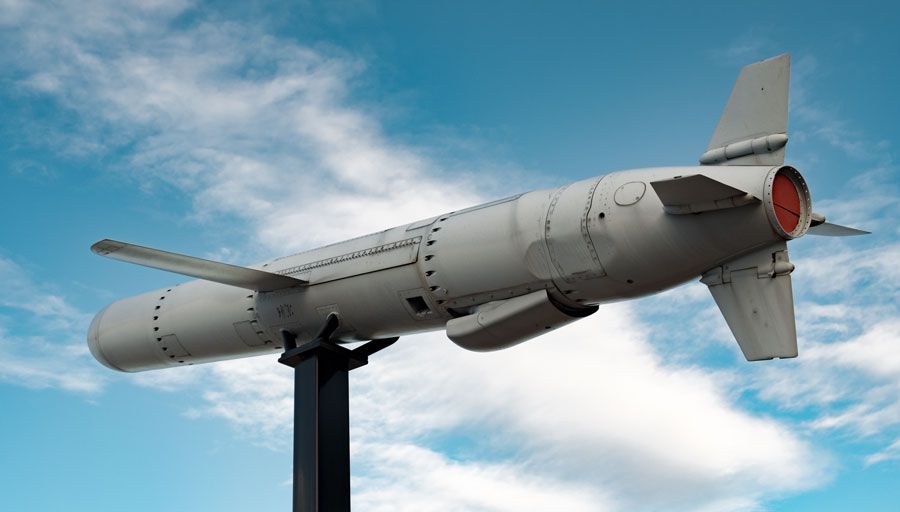
The cruise missile has become one of the preferred weapons of the United States military over the last 20 years. The Gryphon is a mobile Ground Launched Cruise Missile (GLCM) designed to serve as a tactical nuclear weapon in Europe. It is virtually identical to the non-nuclear Tomahawk cruise missiles used by the United States in several Middle East conflicts. Beginning in 1983 BGM-109Gs were stationed in England, Belgium, Germany and Italy. They were wildly unpopular with the populations of these countries and large protests were held in all four nations. In 1987, the United States and the Soviet Union signed the Intermediate Nuclear Forces (INF) Treaty which called for the elimination of the Gryphon and similarly ranged Soviet missiles. This treaty marked the first ever reduction in nuclear forces. The last of them were deactivated in 1991 and all but a handful that were saved for museums were destroyed.
Manufacturers General Dynamics/McDonnell-Douglas
Markings United States Air Force, 1983
Serial Number 12436C0001
Designation BGM-109G
Pima Air & Space Museum
Creating unlimited horizons in aerospace education through the preservation and presentation of the history of flight.
Charity EIN: 86-6031135
Copyright © Website by CS Design Studios
Privacy Policy
Contact Info
520-574-0462
6000 E Valencia Rd, Tucson, AZ 85756
Operating Hours: Open 9 AM – 5 PM Daily Last Admittance at 3:00 PM
- Archaeology
- Anthropology
- Biographies
- Palaeontology
- Palaeoanthropology
- Climate Change
- Natural History
- Space & Planetary
- Tech & Engineering
- All Regions
- North America
- South America

RAF Molesworth’s Ground Launched Cruise Missiles – 25 Years On
Cars and people pass them every day: an empty sentry tower here, a weed-covered “pill-box” there, and a dark tower standing watch over abandoned bunkers..
The infrastructure built to support the ground-launched cruise missile (GLCM) system at RAF Molesworth has become the ghosts of the Cold War era, and October 2013 marked the 25th anniversary of its passing. We were given permission to visit and image the GAMA 25 years on, and the following provides some insights into the status of what was built to be an impenetrable nuclear missile facility.
Tucked away in England’s East Anglia farmland is RAF Molesworth with its long and well-documented history that dates to the early 1900s and is most known for its role supporting the allies during World War II. But, its designation in 1981, to host sixty-four mobile nuclear-tipped missiles garnered a less hospitable response and earned Molesworth a more infamous place in British history.
Together with the better known RAF Greenham Common, RAF Molesworth became a focal point for anti-war and anti-nuclear protests. Despite protests, remaining World War II vestiges such as runways, hardstands, taxis, and other support structures were removed and four hardened bunkers, a watch tower, and extensive perimeter security were built in their place to become the ground-launched cruise missile (GLCM) alert and maintenance area (GAMA).
Missiles deployed to RAF Molesworth in 1986, and the 303rd Tactical Missile Wing, supported by the 87th Tactical Missile Squadron, was activated in December that same year. But, the GLCM mission was short-lived as in 1987 the United States and the former Soviet Union signed the Intermediate-Range Nuclear Forces Treaty, which led to the removal of all nuclear missiles from the base by the end of October 1988. The 303rd Tactical Missile Wing and the 87th Tactical Missile Squadron were both deactivated on 30 January 1989.
To mark the 25th anniversary of its closing, we were given permission to visit and image the bunkers, ground control tower, and supporting infrastructure—sentry towers and security points—to document the condition of the facilities given the almost non-use or significant maintenance for twenty-five years. During its operational heyday, GAMA would have been abuzz with security patrols, blinding perimeter lighting, safety inspectors, and routine military base life. However, except for the occasional clank of loose cables bouncing against inactive antenna poles and a few hares munching on clover patches, there was little to indicate a more modern presence in the GAMA zone.
Perhaps the most mysterious are the bunkers, which remained mostly unlocked and partially accessible but only to those for those who could gain legal access to the base. Rabbit holes dot the dirt covering and thick vegetation has blocked some of the side entrances. Although dry outside, the long sloping concrete tunnel leading into Bunker #26 was damp. We decided to use flashlights rather than the tunnels own lighting until we reached the dryer interior bay. Thirty year-old fluorescent bulbs hummed and flickered as energy flowed through explosion-proof wiring to partially illuminate steel rebar reinforced concrete walls.
Each of the four bunkers contained three bays housing one BGM-109G Gryphon Transporter Erector Launcher (TEL) and sixteen missiles, and two launch control centers and a MAN AG 8 x 8 tractor. During bunker operations, massive hydraulic pistons at both ends raised and lowered thick steel plated bay doors over moat-like trench, and movement between the bays would have been through ship style passages with thick steel doors.
But when closed, the bay doors would sit against steel plates with specialized rubber seals to create an air-tight environment, and each bunker contained an extensive air filtration system to ensure survivability in the event of an attack or accident.
In addition to missile and equipment storage, one of the four bunkers also designed the Command Bunker, which contained an operational center below and possibly sleeping quarters above the missile systems. When the GAMA zone was active, access to the Command Bunker’s operational center was by a ‘down ladder’ through the floor of the bay or from an outside sloping concrete tunneled entrance.
The lower level contained a small kitchen area, a bathroom with a single shower stall, and a conference room with massive air vents. We climbed to the upper bay and was surprised at the near- mint condition of industrial-sized air filtration systems and generators. Critical operational components and communications would have sat behind heavy steel doors, but were removed as part of the closure agreement with the Soviet Union.
There was very little dust and almost no rust on any of the equipment. The only indicator of age was the presence of manual control knobs and pressure gauges instead of today’s digital monitors and computer displays. Although mostly unused after the closure, some modifications included aluminum and corrugated steel frame extensions, chain-drive roll-up doors resting atop the permanently lowered steel panels, and built-in office spaces to support the 423rd Security Forces training area.
Hosting GLCM systems at an active airbase presented security challenges, not just from Cold War era adversaries but from opponents to nuclear weapons. Security personnel would have manned sentry guard towers and communicated with a subterranean concrete bunker nest and an U-shaped concrete firing position likely intended for the M113 armored personnel carrier and a .50 caliber M2 machine gun.
As part of the reclamation process, base managers removed all of the sentry towers shortly after we concluded our documentation. The other vestiges will probably remain in place until fully reclaimed by nature as breaking and removing the concrete would not be cost-effective.
As part of that security system, and the most notable artifact of the GAMA zone is the aqua-tinted glass cube sitting atop the four-story tall ground control tower. When GAMA was active, the tower ran off its own power system. Today, no power runs through the tower’s system. We began our 150ft climb up the narrow, bird-waste encrusted metal stair case wearing make-shift hazmat suits and carrying flashlights. Even with air masks, the stench of 25 years powerful.
The tower offers a stunning 360 degree view that stretches for miles into the British country side. But, what remained of the control panels and security system was covered in bird droppings, feathers, bones, and material from the partially collapsed roof. A security officer would have kept a close watch on the square BARC monitors and dutifully managed the security control panel which probably displayed myriad flashing and solid lights on a flat panel. Today, the tower is occupied by pigeons and other fowl, which enter through the partially collapsed roof top and open windows.
Despite its long-inactive status, the GAMA zone’s bunkers, tower, and perimeter security system still presents a mysterious profile when viewed from outside the main base. Twenty-five years on, the GLCM facility still serves as a stark reminder of the Cold War era now sitting empty and in an eerily quiet state of decay.
Written by Cindy Eccles
Contributing Source : CAECCLES

Archaeologists explore submerged Mesolithic site of Bouldnor Cliff
Origins of “excalibur” sword identified by archaeologists, new type of amphora found on roman shipwreck, archaeologists reveal hundreds of ancient monuments using lidar, archaeologists use revolutionary gpr robot to explore viking age site, highway construction delayed following bronze age discoveries, archaeologists uncover possible phallus carving at roman vindolanda, carbonised herculaneum papyrus reveals burial place of plato, sealed 18th century glass bottles discovered at george washington’s mount vernon.

Mobile Application

Related Articles
HeritageDaily is a dedicated team of passionate historians, archaeologists, writers, and researchers, who are committed to delivering accurate, independent, and insightful content about our rich global heritage.
Our Company
HeritageDaily LTD - Suite/Unit 40 17 Holywell Hill, St Albans, Herts, United Kingdom, AL1 1DT
- HeritageDaily
- DinosaurDaily
- HeritageJewellery
- HeritageMagazine
- Google News Channel
- iOS & Android Application
Latest News
Popular news, the mystery of tutankhamun’s meteoric iron dagger, legio v macedonica – the last roman legion, atlantis – the story behind the legend, the immortal armour of china’s jade burial suits, the pleasure villa of emperor tiberius.
- Terms & Conditions
- Cookie Policy
- Privacy Policy
- Editorial Guidelines
- Submit An Article
© 2024 - HERITAGEDAILY LTD
----- HISTORICAL RECORD -----
BGM-109G Gryphon ground-launched cruise missile
Description.
The BGM-109G Gryphon was a mobile, long-range, theater nuclear cruise missile system that was deployed from 1983 to 1991 with U.S. Air Force units in Belgium, West Germany, Italy, the Netherlands. and the U.K. The missile was developed from the Navy's non-nuclear BGM-109 Tomahawk . The missile featured a torpedo-shaped fuselage with a ventral turbofan intake. The unswept wings and tail surfaces all "popped-out" after launch
The Gryphon was a winged, subsonic missile with the...
Please log in to continue reading.
Not yet a subscriber? Take a free trial.
Military Periscope gives you easy-to-use, integrated, open-source intelligence on…
- More than 7,500 weapons systems and platforms
- Nearly every country's armed forces
- Militant organizations
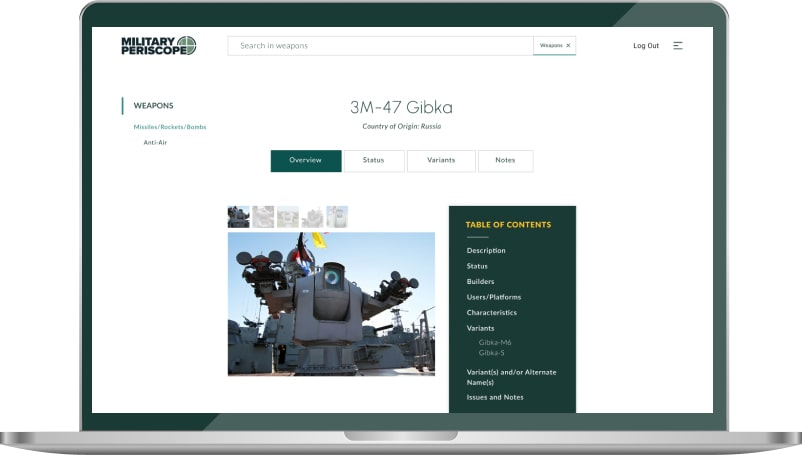
Try Military Periscope free for seven days
Your online source for military news, weapons, and nation's armed forces worldwide
Military Periscope FEDLINK information
Service ID: UC
Contract Number: LCFDL24D0002
Military Periscope is a product of GovExec.
600 New Hampshire Ave., Suite 510,
Washington DC, 20037, USA.
©Military Periscope 2024
All rights reserved. Redistribution of the content is prohibited without prior consent of Military Periscope.
BGM-109G Ground Launched Cruise Missile
The Ground Launched Cruise Missile , or GLCM , (officially designated BGM-109G Gryphon ) was a ground-launched cruise missile developed by the United States Air Force in the last decade of the Cold War and disarmed under the INF Treaty .
Design and employment
Nato deployment and protests, intermediate-range nuclear forces treaty, usaf bgm-109g glcm units, bibliography, external links.
The BGM-109G was developed as a counter to the mobile MRBM and IRBM nuclear missiles ( SS-20 Saber ) deployed by the Soviet Union in Eastern Bloc European countries . The GLCM and the U.S. Army 's Pershing II may have been the incentives that fostered Soviet willingness to sign the Intermediate-Range Nuclear Forces Treaty (INF treaty), and thus possibly reduced the threat of nuclear wars in Europe. GLCM is also a generic term for any ground-launched cruise missile. [ citation needed ] Since the U.S. deployed only one modern cruise missile in the tactical role, the GLCM name stuck. The GLCM was built by General Dynamics .
A conventionally configured cruise missile, the BGM-109 was essentially a small, pilotless flying machine, powered by a turbofan engine. Unlike ballistic missiles , whose aimpoint is usually determined by gravitic trajectories, a cruise missile is capable of complicated aerial manoeuvres, and can fly a range of predetermined flight plans. Also, it flies at much lower altitudes than a ballistic missile, typically with a terrain-hugging flight plan. The trade-off for this low-observability flight is strike time; cruise missiles travel far more slowly than a ballistic weapon, and the GLCM was typical in this regard.

GLCM was developed as a ground-launched variant of the Tomahawk cruise missile in use by the U.S. Navy (along with an undeveloped air-launched version, the Medium Range Air to Surface Missile (MRASM)). Unlike other variants of the Tomahawk, the GLCM carried only a W84 thermonuclear warhead ; no conventional capability was provided. The W84 warhead is a 0.2–150kt variable-yield weapon. [2] This yield contrasts with the yield of the W80 warhead found on other versions of the Tomahawk and on the ALCM from which the W84 was derived, which has a selectable yield of 5 or 150 kt. [3] The official range of the weapon was 2,780 kilometres (1,730 mi) . [4] Like other U.S. cruise missiles of this period, accuracy after more than 2000 km of flight was approximately 30 meters. The missile was entirely subsonic , powered by a turbofan engine with a rocket booster assisting at launch. [1]
This contrasted strongly with Pershing II , which had a flight time of 10–15 minutes. However, the range of the GLCM gave it the ability to strike deep within then- Soviet territory, and the missile guidance and low radar cross-section would have made it far more difficult to intercept a GLCM even if the launch were detected in time. [lower-alpha 1]
BGM-109G personnel were trained at Davis-Monthan Air Force Base , Arizona, by the 868th Tactical Missile Training Squadron from 1 July 1981. On 1 October 1985, the squadron became part of the 868th Tactical Missile Training Group. The group and squadron were inactivated on 31 May 1990. An area near Fort Huachuca , Arizona was used for field training for GLCM flights. GLCM testing was conducted at the Dugway Proving Ground in Utah, with many of the people involved in the testing going to operational wings as they were activated.

BGM-109G missiles would be based at six locations throughout Europe; in the United Kingdom (at RAF Greenham Common and RAF Molesworth ), Belgium, Woensdrecht AB Netherlands, Germany, and Comiso Air Station in Italy. Each location had its own unique problems, but all required extensive construction by the USAF. Initial operating capability (IOC) occurred in 1983. [5]
Normal basing was in blast shelters at military installations. Each BGM-109G station was controlled by a Wing that consisted of a Tactical Missile Squadron (TMS), which was responsible for operation and deployment of the missiles; and a Tactical Missile Maintenance Squadron (TMMS), which was responsible for the support of the system. Each TMS consisted of several flights, made up of 69 people and 22 vehicles. [5] The missile was designed to operate in a flight with sixteen missiles. The flight would be normally on base, with the missiles and vehicles secured in the hardened storage area called the GAMA (GLCM Alert and Maintenance Area).
Four transporter erector launchers (TEL) each carried four BGM-109G missiles in their containers and ready for launch. Two launch control centers (LCC), each with two launch officers, were connected to the TELs and interconnected for launch. Each TEL and LCC was towed by a large MAN KAT1 8x8 tractor and was capable of traversing rough terrain. There were 16 support vehicles for the flight commander, normally a captain, 19 maintenance technicians, a medical technician and 44 security personnel. [5]
During periods of increased tension, the flights would be deployed to pre-surveyed, classified locations in the countryside away from the base. The members of the flight would dig in, erect camouflage netting to hide the vehicles, and prepare for launch. Flight commanders were tasked to survey and select possible deployment sites, with all details closely held, and the commander selected the location preferred when the flight deployed from the base. When deployed, the flight was self-sustaining, and secured with special intrusion detection radar. The launchers (without warheads) were sent out on a number of simulated scrambles. [5]
Although deployed in the face of a range of Soviet IRBMs , including the brand-new and extremely capable SS-20 Saber, the GLCM (sometimes referred to by its phonetic nickname, Glick-em) faced widespread public protest in Europe. Anti-nuclear groups such as the Campaign for Nuclear Disarmament felt that the United States was deploying weapons meant to win a tactical nuclear war, without adequate consideration of the effects that even a 'victory' would bring. Between them, GLCM and Pershing II made a lethal combination. GLCM missiles could be launched, undetected, followed 2 hours later by a Pershing strike, which would fly so quickly that it was possible no response could be made before the Pershings struck. Aside from presenting a course of action to NATO commanders in the event of war, it put the Kremlin leaders (in range of the GLCM and possibly the Pershing, even in Moscow ) in a position of fearing a decapitating NATO first strike , which could have moved them toward a launch on warning policy as the only way to maintain mutually assured destruction . [6] However, the USSR did have submarine-launched missiles (i.e. Golf and Hotel class SSBNs armed with R-27 Zyb and SS-N-5s ) available during this time, so any fears of a decapitating first strike were not necessarily justified. [7]

Despite initial fears of greater instability, the deployment of GLCM ultimately caused Soviet leaders to enter into negotiations for, and finally, sign off on, the INF treaty . The recognition by Soviet leaders of the threat posed by the GLCM and Pershing II missiles made them far more inclined to agree to negotiate their own intermediate-range weapons, especially the SS-20, out of service, in exchange for the elimination of the threat posed by the GLCM and the Pershing II. [8]
Unlike SALT II or START I , which set limits to maximum nuclear arsenals, the INF Treaty banned whole categories of intermediate-range tactical nuclear weapons outright. All ground-launched cruise missiles and ballistic missiles with ranges greater than 500 but less than 5500 kilometers were barred to the U.S. and USSR under this treaty. This meant the withdrawal of GLCM and Pershing II on the American side. The Soviets withdrew the GLCM's most direct counterpart, the SSC-4 or RK-55 , and its supersonic follow-on, the SSC-X-5 . In addition, various Soviet MRBMs , IRBMs , and LRBMs were withdrawn: the SS-4 Sandal , SS-5 Skean , SS-12 Scaleboard , SS-20 Saber , SS-22 Scaleboard B, and SS-23 Spider . All of these equivalent weapons had been developed and deployed against NATO forces before the introduction of the GLCM, despite the categorization of the GLCM deployment by communists as 'aggressive'. [9]

GLCM was removed from Europe beginning in 1988, and over the next three and a half years all units were transported to Davis Monthan AFB and destroyed or converted into displays by 1991. Eight missiles survive for inert static display only. [5]
In February 2018, U.S. military officials confirmed they were developing a new ground-launched, intermediate-range cruise missile to counter Russian development of a similar weapon system that violates the INF Treaty. [10] President Donald Trump announced on 20 October 2018 that he was withdrawing the U.S. from the INF treaty, citing Russian non-compliance. [11] The United States formally withdrew from the treaty on 2 August 2019. [12]
Download coordinates as:
- GPX (all coordinates)
- GPX (primary coordinates)
- GPX (secondary coordinates)
- 38th Tactical Missile Wing - Pydna Missile Base) at Wüschheim AB , West Germany (1985–1990)
- 303d Tactical Missile Wing - RAF Molesworth , United Kingdom (1986–1989)
- 485th Tactical Missile Wing - Florennes Air Base , Belgium (1984–1989)
- 486th Tactical Missile Wing - Woensdrecht Air Base , Netherlands (1987–1988)
- 487th Tactical Missile Wing - Comiso Air Base , Italy (1983–1991)
- 501st Tactical Missile Wing - RAF Greenham Common , United Kingdom (1982–1991)
- 868th Tactical Missile Training Squadron , Activated 1 July 1981
Note: Each GLCM squadron was further subdivided into several flights. Each flight included 2 Launch Control Vehicles (LCC) and 4 Transporter Erector Launchers (TEL), totalling 16 missiles per flight. Each TEL could carry 4 missiles. [14] [15]

- Tomahawk SLCM
- SSC-X-4/RK-55
- List of nuclear weapons
- ↑ The Mikoyan MiG-31 's Zaslon radar has look-down/shoot-down function, and was specifically designed to intercept low-flying bombers and cruise missiles. Same radar function on the Beriev A-50 .
Related Research Articles

A cruise missile is a guided missile used against terrestrial or naval targets, that remains in the atmosphere and flies the major portion of its flight path at an approximately constant speed. Cruise missiles are designed to deliver a large warhead over long distances with high precision. Modern cruise missiles are capable of traveling at high subsonic, supersonic, or hypersonic speeds, are self-navigating, and are able to fly on a non-ballistic, extremely low-altitude trajectory.

The Tomahawk Land Attack Missile ( TLAM ) is a long-range, all-weather, jet-powered, subsonic cruise missile that is primarily used by the United States Navy and Royal Navy in ship and submarine-based land-attack operations.

The Intermediate-Range Nuclear Forces Treaty was an arms control treaty between the United States and the Soviet Union. US President Ronald Reagan and Soviet General Secretary Mikhail Gorbachev signed the treaty on 8 December 1987. The US Senate approved the treaty on 27 May 1988, and Reagan and Gorbachev ratified it on 1 June 1988.

The RSD-10 Pioneer was an intermediate-range ballistic missile with a nuclear warhead, deployed by the Soviet Union from 1976 to 1988. It carried GRAU designation 15Ж45 ( 15Zh45 ). Its NATO reporting name was SS-20 Saber .

Pydna is a former American missile base in Kastellaun, Germany named Wueschheim Air Station.

The 501st Combat Support Wing is an administrative support wing of the United States Air Force, based at RAF Alconbury, United Kingdom. It is one of three wings located in the United Kingdom as components of the Third Air Force and United States Air Forces in Europe – Air Forces Africa (USAFE).

The NATO Double-Track Decision was the decision by NATO from December 12, 1979, to offer the Warsaw Pact a mutual limitation of medium-range ballistic missiles and intermediate-range ballistic missiles. It was combined with a threat by NATO to deploy more medium-range nuclear weapons in Western Europe after the Euromissile Crisis.

The 487th Air Expeditionary Wing is a provisional United States Air Force unit assigned to the United States Air Forces in Europe. As a provisional unit, it may be activated or inactivated at any time. The unit's last known assignment was in 2003 at Cairo West Air Base, Egypt, during Operation Iraqi Freedom.

The 486th Air Expeditionary Wing is a provisional United States Air Force unit assigned to the Air Combat Command. As a provisional unit, it may be activated or inactivated at any time.
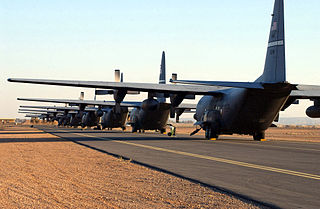
The 485th Air Expeditionary Wing is a provisional United States Air Force unit assigned to Air Combat Command. As a provisional unit, the 485 AEW may be inactivated or activated at any time by Air Combat Command. The wing was last known to be active during Operation Iraqi Freedom in 2003 at Tabuk Regional Airport, Saudi Arabia, in 2003.

The 38th Combat Support Wing is an inactive wing of the United States Air Force. Its last assignment was with Third Air Force at Ramstein Air Base, Germany from 2004 until 2007. The mission of the wing was to enhance support to Third Air Force's geographically separated units.

The 303rd Aeronautical Systems Wing was a United States Air Force unit assigned to the Air Force Materiel Command Aeronautical Systems Center, 2005-2010. It was stationed at Wright-Patterson Air Force Base, Ohio as a tenant unit.

The 71st Tactical Missile Squadron is an inactive United States Air Force unit. It was last assigned to the 485th Tactical Missile Wing at Florennes Air Base, Belgium, where it was inactivated on 30 September 1989 with the implementation of the Intermediate-Range Nuclear Forces Treaty.

Comiso Airport "Pio La Torre", also known as Vincenzo Magliocco Airport , is an airport located in the town of Comiso in the Province of Ragusa, Sicily, Italy. The airport serves Comiso (5 km), Ragusa, Vittoria and Gela. It changed from military to civil use during 2005–2008. The airport was opened to commercial and general aviation 30 May 2013.
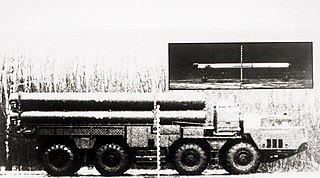
The Novator RK-55 Relief is a Russian Navy cruise missile that is launched either from submarines (SLCM) or from surface ships. It can have a nuclear warhead developed in the Soviet Union. A version launched from submarine torpedo tubes, the S-10 Granat , has apparently been converted to carry conventional warheads and continues in service to this day. The Russian Federation was reported to have deployed the derivative SS-CX-7/SS-CX-8 systems on 14 February 2017. The land launched version is called the Novator 9M729.

The 868th Tactical Missile Training Squadron is an inactive unit of the United States Air Force. Its last assignment was with the 868th Tactical Missile Training Group, at Davis Monthan Air Force Base, Arizona, where it conducted training with the BGM-109G Gryphon. It was inactivated on 31 May 1990.

The 87th Tactical Missile Squadron is an inactive squadron of the United States Air Force last based at RAF Molesworth, England. The squadron was originally activated as the 8th Reconnaissance Squadron . The unit served on antisubmarine patrol early in World War II, then as a training unit until it was disbanded in 1944.

The 302nd Tactical Missile Squadron is an inactive United States Air Force unit. Its last assignment was with the 487th Tactical Missile Wing at Comiso Air Station, Italy, where it was inactivated in 1991 with the implementation of the Intermediate Range Nuclear Forces Treaty.

The Pershing II Weapon System was a solid-fueled two-stage medium-range ballistic missile designed and built by Martin Marietta to replace the Pershing 1a Field Artillery Missile System as the United States Army's primary nuclear-capable theater-level weapon. The U.S. Army replaced the Pershing 1a with the Pershing II Weapon System in 1983, while the German Air Force retained Pershing 1a until all Pershings were eliminated in 1991. The U.S. Army Missile Command (MICOM) managed the development and improvements, while the Field Artillery Branch deployed the systems and developed tactical doctrine.
- 1 2 Cochran, Arkin & Hoenig 1984 , pp. 179–184.
- ↑ "The W80 Warhead" , USA , Nuclear weapon archive .
- ↑ Sandia Weapon Review: Nuclear Weapon Characteristics Handbook (PDF) (Report). Sandia National Labs. September 1990. p. 78. SAND90-1238.
- 1 2 3 4 5 General Dynamics/McDonnell Douglas BGM-109G "Gryphon" Ground-launched Cruise Missile Archived 17 February 2006 at the Wayback Machine
- ↑ Grier, Peter. "The Short, Happy Life of the Glick-Em". Air Force Magazine . 85 (July 2002): 70–74.
- ↑ "ICBMs" . Archived from the original on 7 October 2009.
- ↑ Werrell, Kenneth P. (1989). "The Weapon the Military Did Not Want: The Modern Strategic Cruise Missile". The Journal of Military History . 53 (October 1989): 419–438. doi : 10.2307/1986108 . JSTOR 1986108 .
- ↑ "INF Theater / Operational Missiles" . Russian / Soviet Nuclear Forces . FAS.
- ↑ Pentagon Confirms It’s Developing Nuclear Cruise Missile to Counter a Similar Russian One . Defense One . 2 February 2018.
- ↑ Pengelly, Martin (20 October 2018). "Trump says US will withdraw from nuclear arms treaty with Russia" . The Guardian . Retrieved 20 October 2018 .
- ↑ "INF nuclear treaty: US pulls out of Cold War-era pact with Russia" . BBC News . 2 August 2019.
- ↑ "Air Force Magazine" (PDF) .
- ↑ AAFM Newsletter, Volume 12, Number 4, dated December 2004, article "GLCM Part I" by Col (Ret) Charlie Simpson. Archived 30 September 2011 at the Wayback Machine
- ↑ "The Missile Forums • View topic - GLCM Unit Order of Battle" . Archived from the original on 16 March 2012 . Retrieved 25 June 2011 .
- Cochran, Thomas; Arkin, William M.; Hoenig, Milton M. (1984). Nuclear Weapons Databook Volume I: U.S. Nuclear Forces and Capabilities . Natural Resources Defense Council. ISBN 0-88410-173-8 .
- GLCM (Ground-Launched Cruise Missile): BGM-109G Gryphon - Designation Systems
- 485th Tactical Missile Wing
- 38 TMW Wueschheim Germany
- 501st Tactical Missile Wing at Greenham Common
![F-111 Aardvark Index Page [Click for more ...] bgm 109g ground launched cruise missile](https://ausairpower.net/APA/f-111.png)
After Leaving Treaty, U.S. Tests Ground Launched Cruise Missile
The unnamed cruise missile was developed in response to Russia’s fielding of similar ground launched missiles.
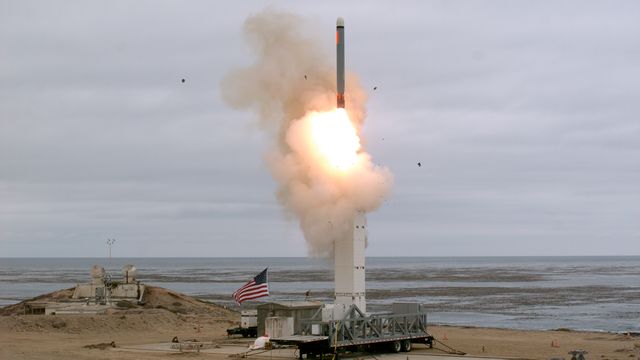
- The missile was once banned under the INF treaty and looks like a tomahawk cruise missile.
- The test was likely a response to U.S. accusations that Russia as been flouting the treaty for some time.
The U.S. has tested a new ground launched cruise missile just weeks after a treaty banning them expired. The new missile, previously banned under the Intermediate Range Forces Treaty (INF), was launched yesterday, August 18th, 2019, off the coast of California. The U.S. walked away from the INF Treaty after repeatedly accusing Russia of violating the treaty.
The missile test took place on August 18th, 2019, on San Nicolas Island. Part of California’s Channel Islands, San Nicolas is a military reservation and part of Naval Base Ventura County. According to the Department of Defense , “The test missile exited its ground mobile launcher and accurately impacted its target after more than 500 kilometers of flight. Data collected and lessons learned from this test will inform the Department of Defense's development of future intermediate-range capabilities.”
The missile looks like a Tomahawk cruise missile, a bullet-shaped, stubby-winged, low flying missile first used in the 1991 Gulf War. The Tomahawk was adapted into land, air, and sea-launched versions, for use against land targets and ships. A land-based version, the BGM-109G Gryphon, was stationed in Europe in the 1980s until the ratification of the Intermediate Range Forces Treaty in 1987.
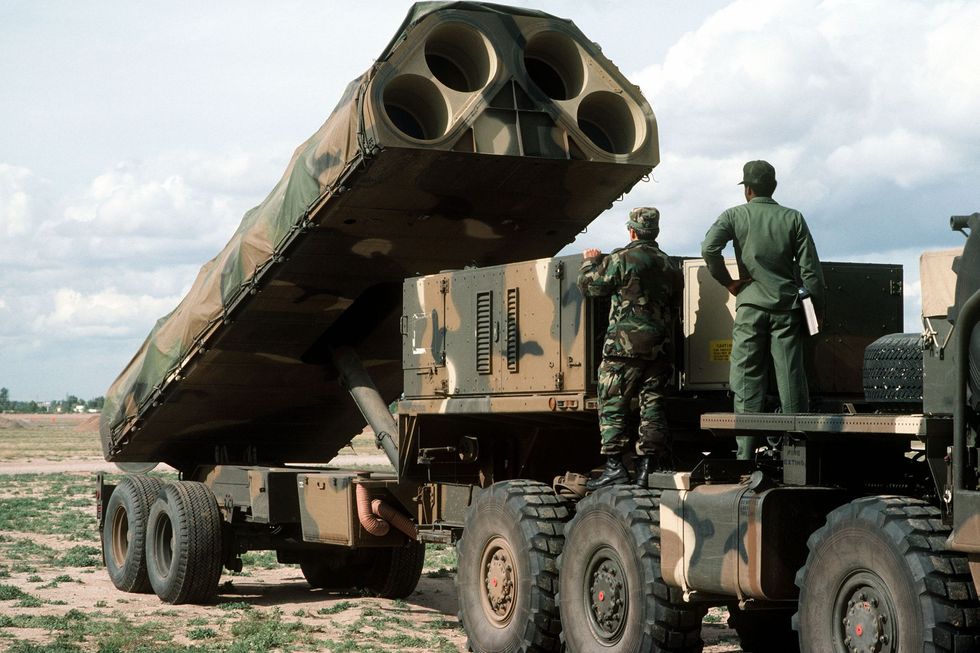
The INF Treaty , negotiated between the U.S. and Soviet Union in the late 1980s, was designed to remove intermediate range nuclear weapons from the arsenals of both countries. The INF treaty required both countries to destroy ground-launched missiles with ranges of 500 kilometers (310 miles) to 5,500 kilometers (3,417) miles. Thousands of missiles were scrapped on both sides and for the first time, an entire class of nuclear delivery systems was banned.
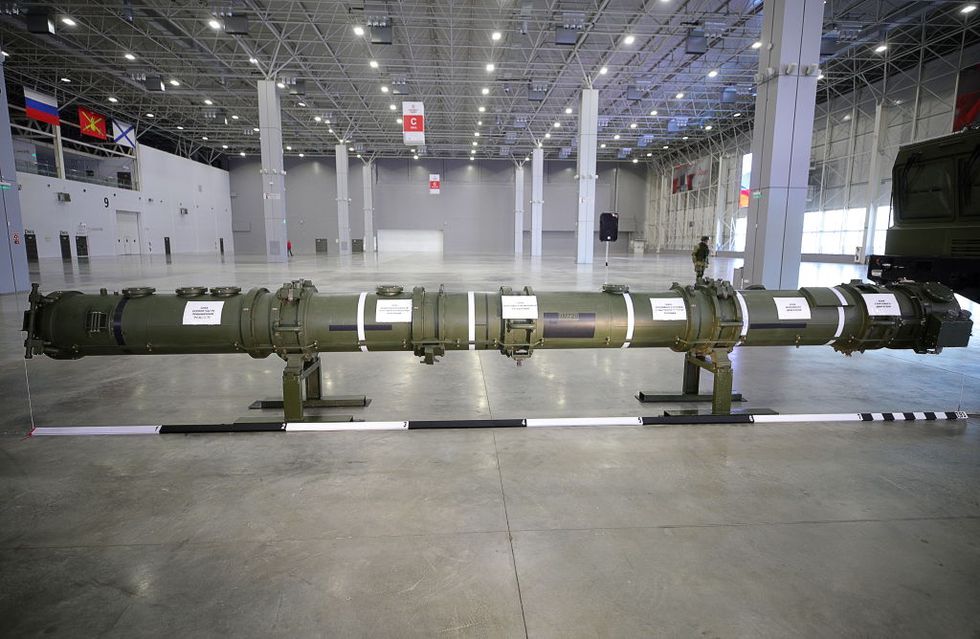
In December 2018, the U.S. formally accused Russia of fielding a new ground launched cruise missile, known as 9M729 or “Iskander M” in Russia, and the U.S. intelligence community and NATO as SSC-8, or “Screwdriver.” In January, Moscow held an event designed to convince skeptics 9M729 was within treaty limits, but the U.S. and NATO were not convinced.
The missile is likely a land-based version of Tomahawk Land Attack Cruise Missile, or TLAM, Block IV E. Block IV E is designed to launch from a Mark 41 vertical launch system silo on a warship. The cruise missile is powered by a turbofan engine, the same type of engine that powers civilian airliners and military aircraft, only scaled down to fit in a missile with a 21-inch diameter. A fuel efficient engine, subsonic flight profile, and internal fuel supply gives Block IV E a range of 900 nautical miles, or 1,000 miles.
The Tomahawk’s basic design is 40 years old, but the Pentagon has made periodic updates to the guidance system and electronics. Today’s Tomahawk is guided by GPS and has the ability to store coordinates for several targets in its electronic brain. If friendly strikes destroy its primary target, it can take a picture of the damage done and loiter nearby until planners decide to re-attack the target or send the missile to attack an alternate. The missile also features a 1,000 pound blast fragmentation warhead.
The U.s. has committed to fielding two new missiles that were banned by the INF Treaty, a new cruise missile and a new intermediate range ballistic missile. Contrary to name the INF Treaty didn’t ban nuclear warheads, just the missiles that delivered them to targets. but the U.S. has also said the new missiles will not carry nuclear warheads—for now anyway.
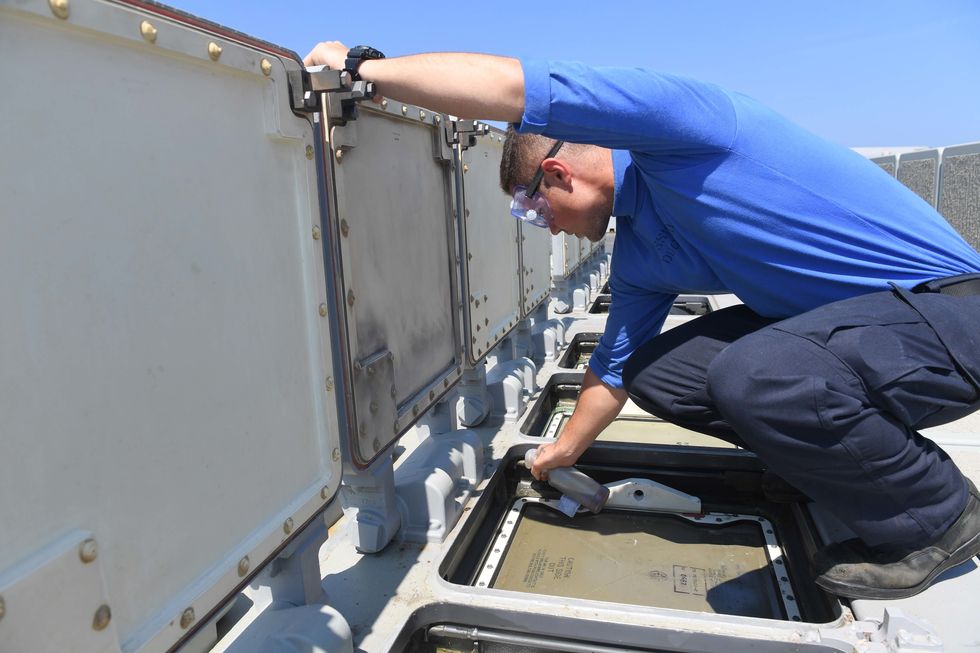
This past weekend's missile test, according to Defense News , was launched from a land-based Mark 41 launcher . The U.S. has dozens of Mark 41 launchers in Romania and Poland as part of a regional ballistic missile defense system, one designed to protect Europe from missile attack. Russia has claimed that the Mark 41 launchers themselves were INF Treaty violations, as they could carry TLAMs instead of ballistic missile interceptors. U.S. missile experts have responded in the past claiming the launchers deployed in Europe were a version incapable of launching cruise missiles.
The death of the INF Treaty is a boon for watchers of the Asia-Pacific region, where China has hundreds if not thousands of short-, medium-, and intermediate-range missiles with both conventional and nuclear warheads. China, not a signatory to the INF treaty, developed ballistic missiles as a cheaper alternative to tactical airpower, particularly long range bombers, and in a war experts believe China could shower U.S. bases in the region with missiles , shutting them down and rolling American military power back as far as Hawaii.
New cruise and intermediate-range missiles could threaten Chinese missiles, taking them out before they can launch against U.S. forces.

Kyle Mizokami is a writer on defense and security issues and has been at Popular Mechanics since 2015. If it involves explosions or projectiles, he's generally in favor of it. Kyle’s articles have appeared at The Daily Beast, U.S. Naval Institute News, The Diplomat, Foreign Policy, Combat Aircraft Monthly, VICE News , and others. He lives in San Francisco.

.css-cuqpxl:before{padding-right:0.3125rem;content:'//';display:inline;} Weapons .css-xtujxj:before{padding-left:0.3125rem;content:'//';display:inline;}

A New Hypersonic Missile Will Give the F-35 Fangs

The U.S. Has Built an Unstoppable Microwave Weapon

The Army Has a Plan to Kill Drones

Army: The Days of Towed Artillery Are Over

The US Army Has Deployed Lasers to a Combat Zone

The Manhattan Project's Deadly Legacy in St. Louis
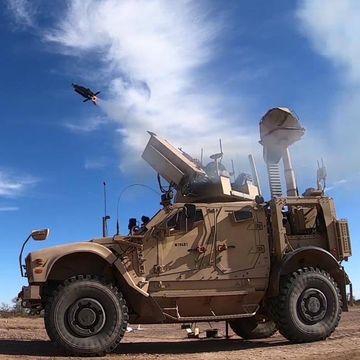
The Army Is Clearing Out for Coyote Drone Hunters
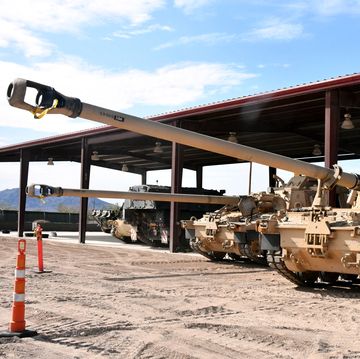
This Long-Range Howitzer Has Met Its Achilles Heel

Inside the Development of America's New Nuke
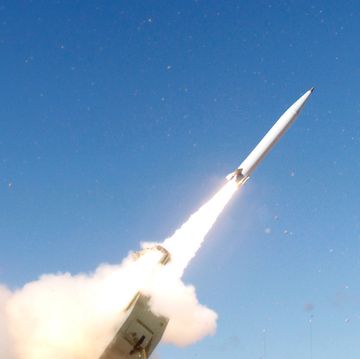
What’s in the Pentagon’s 2025 Defense Budget
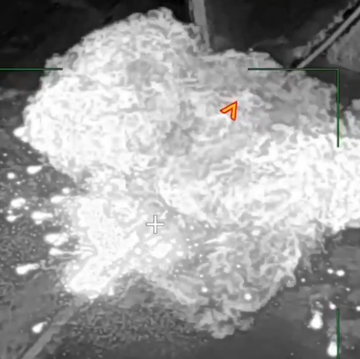
A Ballistic Missile’s Wrath Wreaks Havoc
BGM-109G Ground Launched Cruise Missile (Q2877027)
- Ground Launched Cruise Missile
- BGM-109G Gryphon

Identifiers
Wikipedia (10 entries).
- enwiki BGM-109G Ground Launched Cruise Missile
- eswiki BGM-109G Ground Launched Cruise Missile
- frwiki BGM-109G Gryphon
- idwiki BGM-109G Ground Launched Cruise Missile
- jawiki 地上発射巡航ミサイル (アメリカ軍)
- kowiki BGM-109G 그리폰
- ocwiki BGM-109G Gryphon
- plwiki BGM-109G GLCM
- trwiki BGM-109G GLCM
- ukwiki BGM-109G GLCM
Wikibooks (0 entries)
Wikinews (0 entries), wikiquote (0 entries), wikisource (0 entries), wikiversity (0 entries), wikivoyage (0 entries), wiktionary (0 entries), multilingual sites (1 entry).
- commonswiki BGM-109G Gryphon
Navigation menu
NATO M1014 MAN Tractor & BGM-109G Ground Launched Cruise Missile
Modelcollect | no. ua72328 | 1:72.

AGM-109 Tomahawk Cruise Missile
Bgm-109g tomahawk ground launched cruise missile, us air force (1947-now), man kat1 m1014, box contents.
Dimensions: 330x245x60 mm (13x9.6x2.4 inch)
Weight: 410 g (0.9 lbs)
Product timeline

Instructions
Download 8200Kb (.pdf)
Marketplace
Online shops.

Alternative SKUs for Modelcollect UA72328 : MC-UA72328 | UA 72328 | MCLUA72328 | MOD-UA72328
Note: Prices and availability are indications only. Also check if the product actually matches!
Related products

All related products » (14 in total)
In-box reviews
External reviews.
We don't know about any in-box reviews for this M1014 MAN Tractor & BGM-109G Ground Launched Cruise Missile (#UA72328) from Modelcollect.

IMAGES
VIDEO
COMMENTS
BGM-109G on display at the National Museum of US Air Force. GLCM was developed as a ground-launched variant of the Tomahawk cruise missile in use by the U.S. Navy (along with an undeveloped air-launched version, the Medium Range Air to Surface Missile (MRASM)). Unlike other variants of the Tomahawk, the GLCM carried only a W84 thermonuclear ...
The Ground Launched Cruise Missile (GLCM) was a mobile, ground-to-ground cruise missile developed to provide North Atlantic Treaty Organization (NATO) theater commanders with a low-cost, reliable, accurate tactical nuclear missile. ... The BGM-109G Gryphon is almost identical to the BGM-109 Tomahawk non-nuclear sea-launched cruise missile (SLCM ...
The Ground Launched Cruise Missile, or GLCM, (officially designated BGM-109G Gryphon) was a ground-launched cruise missile developed by the United States Air Force in the last decade of the Cold War. The BGM-109G was developed as a counter to the mobile medium- and intermediate- range ballistic nuclear missiles deployed by the Soviet Union in Eastern Bloc European countries. The GLCM and the U ...
The Ground Launched Cruise Missile (GLCM), or BGM-109G Gryphon, was a ground-launched cruise missile developed by the United States in the last decade of the Cold War. The BGM-109G was designed as a counter to the mobile medium and intermediate range ballistic nuclear missiles deployed by the Soviet Union in Eastern Bloc European countries.
Ground Launched Cruise Missile (GLCM), BGM-109G, Gryphon Propulsion: One Williams International F107-WR-102 non-afterburning turbofan engine; one Atlantic Research solid-fuel rocket booster for launch Wingspan: 8 ft 7 in. Length: 18 ft 2 in, Diameter: 1 ft 9 in, Weight: 2,650 lbs. Speed: 500 mph, Range: 1,500 miles.
BGM-109G Gryphon. The BMG-109 Gryphon or Ground Launched Cruise Missile (GLCM) was a road-mobile, ground-launched variant of the Tomahawk that carried a nuclear payload. Development began in the early 1970s and it became operational in 1984. 7. The GLCM had a range of 2,500 km and could reach speeds of approximately 800 kph.
The Air Force's BGM-109G GLCM, nicknamed Gryphon, did not begin life as an Air Force system. It was a modified version of the Navy's Tomahawk sea launched cruise missile. Development began in 1977. Because of the political need for the system, the GLCM passed rapidly from concept through development, but its progress was not always smooth.
BGM-109G Ground Launched Cruise Missile (GLCM) with a W84 nuclear warhead; withdrawn from service in 1991 AGM-109H/L Medium Range Air to Surface Missile (MRASM) a shorter range, turbojet powered air-launched cruise missile with cluster munitions; never entered service, cost US$569,000 (1999)
BGM-109G on display at the National Museum of US Air Force. GLCM was developed as a ground-launched variant of the Tomahawk cruise missile in use by the U.S. Navy (along with an undeveloped air-launched version, the Medium Range Air to Surface Missile (MRASM)). Unlike other variants of the Tomahawk, the GLCM carried only a W84 thermonuclear ...
English: The Ground Launched Cruise Missile, or GLCM, (officially designated BGM-109G Gryphon) was a ground-launched cruise missile developed by the United States Air Force in the last decade of the Cold War. Deutsch: Das Ground Launched Cruise Missile, kurz GLCM, (offiziell als BGM-109G Gryphon bekannt) war ein Marschflugkörper, der vom Boden ...
The Air Force's BGM-109G Ground-Launched Cruise Missile (GLCM) was a Navy BGM-109A Tomahawk modified to fire from a Transporter-Erector-Launcher (TEL) truck. Recreating it would cost about $100 ...
Ground Launched Cruise Missile, or GLCM, (officially designated BGM-109G Gryphon) was a ground-launched cruise missile developed by the United States Air For...
Raytheon (General Dynamics) AGM/BGM/RGM/UGM-109 Tomahawk The Tomahawk is the U.S. Navy's multipurpose strategic and tactical long range precision-guided cruise missile. Launched from surface ships and submarines, it was used in action in all recent major U.S. military engagements, and will remain one of the most important missiles in the U.S. inventory for quite some time.
BGM-109G Ground Launched Cruise Missile (GLCM) - with a W84 nuclear warhead; withdrawn from service in 1991 to comply with the INF Treaty. AGM-109H/L Medium Range Air-to-Surface Missile (MRASM) - a shorter-range, turbojet powered air-launched cruise missile with cluster munitions; never entered service, cost US$ 569,000 (1999).
General Dynamics/McDonnell-Douglas BGM-109G Gryphon. The cruise missile has become one of the preferred weapons of the United States military over the last 20 years. The Gryphon is a mobile Ground Launched Cruise Missile (GLCM) designed to serve as a tactical nuclear weapon in Europe. It is virtually identical to the non-nuclear Tomahawk cruise ...
The infrastructure built to support the ground-launched cruise missile (GLCM) system at RAF Molesworth has become the ghosts of the Cold War era, and October 2013 marked the 25th anniversary of its passing. ... Each of the four bunkers contained three bays housing one BGM-109G Gryphon Transporter Erector Launcher (TEL) and sixteen missiles, and ...
The BGM-109G Gryphon was a mobile, long-range, theater nuclear cruise missile system that was deployed from 1983 to 1991 with U.S. Air Force units in Belgium, West Germany, Italy, the Netherlands. and the U.K. The missile was developed from the Navy's non-nuclear BGM-109 Tomahawk.
A dispersed launch site for a BGM-109G Gryphon missile TEL A Soviet inspector examines a BGM-109G ground-launched cruise missile in 1988 prior to its destruction. BGM-109G missiles would be based at six locations throughout Europe; in the United Kingdom (at RAF Greenham Common and RAF Molesworth ), Belgium, Woensdrecht AB Netherlands, Germany ...
BGM-109G Ground Launched Cruise Missile (GLCM) The GLCM was without doubt the most strategically important of the early Tomahawk variants. Deployed in Europe to balance the Soviet SS-20 force, the GLCM drove the Soviets to the negotiating table. The GLCM stock was subsequently destroyed in compliance with the resulting treaty.
The unnamed cruise missile was developed in response to Russia's fielding of similar ground launched missiles. Search. ... the BGM-109G Gryphon, was stationed in Europe in the 1980s until the ...
This is "BGM-109G Ground Launched Cruise Missile" by steve wallis on Vimeo, the home for high quality videos and the people who love them. Solutions . Video marketing. Power your marketing strategy with perfectly branded videos to drive better ROI. Event marketing. Host virtual events and webinars to increase engagement and generate leads. ...
Ground Launched Cruise Missile; BGM-109G Gryphon; Statements. instance of. missile model. 0 references. former entity. 0 references. subclass of. BGM-109 Tomahawk. 0 references. ground-launched cruise missile. 0 references. image. BGM-109G Gryphon - ID DF-ST-84-09185.JPEG 2,870 × 1,912; 1.09 MB. 1 reference. imported from Wikimedia project.
NATO M1014 MAN Tractor & BGM-109G Ground Launched Cruise Missile Number: UA72328 Scale: 1:72 Type: Full kit Released: 2019 New parts Barcode: 4589913281530 (EAN) Packaging: Rigid box (Top opener) Markings AGM-109 Tomahawk Cruise Missile BGM-109G Tomahawk Ground Launched Cruise Missile US Air Force (1947-now) FS34087.